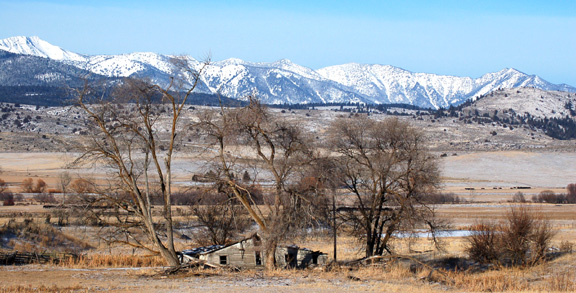- “Little Butterflies” of North East Oregon
- Fleecing Baker City (& The Poor Man's House)
Some “Little Butterflies” of North East Oregon
While strolling through a meadow full of flowers or along a portion of a sunlit, muddied path in the woods, you probably have noticed small attractive butterflies of a blue or coppery cast flitting about. They are often seen sipping nectar from flowers or taking up moisture and nutrients from the edges of puddles or streams. They are the “Gossamer Wings” or “little butterflies,” of the family Lycaenidae, in the order Lepidoptera (moths & butterflies), belonging to class Insecta, the insects. They are a bit difficult to get a good view of without close-range binoculars or a good deal of luck and patience, as their wingspans may be as small as 7/8th inch, with few being as wide as 2 inches.

Blue butterflies congregating near lakeshore on Steen’s Mountain
Within the family of little butterflies are found the Metalmarks, the Harvesters, Hairstreaks (hairstreaks and efins), the Coppers, and the Blues. In our neck of the woods, as in North America, the hairstreaks are the most numerous, closely followed by the blues and then the coppers. The others here are far less frequent, with only one metalmark species and no harvesters occurring here.
As in all other butterflies, the little butterflies go through a change called metamorphosis with the life cycle stages from egg, to larva, to pupa, and then the adult butterfly that we may enjoy. The eggs are normally laid on or near the plant that the larvae will use as a food source, which is called the hostplant. The little butterflies use a variety of hostplants, some of which are discussed below with the butterflies that use them. Adults fly at different times of the year, depending on the needs of the species. Besides color and marking pattern, both hostplant and flight time can be useful aids in identification. Unfortunately, as is the case with many living things, identification can be difficult, even when these things are known, and even experts will disagree. Sometimes, god forbid, you even have to scope out the genitalia of individual butterflies to identify the species.
Here are some of Eastern Oregon’s little butterflies I have been able to get close to.
HAIRSTREAKS
The common name given to hairstreaks, which are often quite beautiful, is due to the streaks of white or brown found on the hindwing, and the fact that males usually have hairlike appendages (tails) on the hindwing as well. One common hairstreak of lower to middle, and even upper elevations, is the Gray Hairstreak (Strymon melinus).
 Gray Hairstreak
Gray HairstreakThis butterfly utilizes many different hostplants, and may produce from one to three broods a year, which helps explain its abundance and large geographic range. In Oregon it utilizes loco weed/milk vetch, wild buckwheats, lupines, mallows, various delectable berries, and more. The adult above was photographed sipping nectar from a wild onion (Allium tolmei) in May, from a site in baker County near Pritchard Creek, below its confluence with Lawrence Creek.
Another common local hairstreak is the Western or California Hairstreak (Satyrium Californica).

 Western or California Hairstreak
Western or California HairstreakWestern Hairstreak is often found sipping nectar from spreading dogbane (Apocynum androsaemifolium), as are the twoabove, during its single flight time. They were photographed west of West Eagle Creek (Union County) in late July of last year at 6000 feet elevation. In Oregon they have been observed from as low as 900 feet and up to 8000 feet in Lake County. The most common hostplant is antelope bitterbrush (Purshia tridentata), although locally it also may use snowbrush ceanothus (Ceanothus velutinus var. velutinus).
Brown Elfin
Elfins and the green hairstreaks (Callophrys affinis), are usually brownish or green butterlies in the hairstreak group that doesn’t have much of a tail. The Brown Elfin (Callophrys augustinus), is one of four elfins found in Baker County.

Brown Elfin
The one above was found with many others on a rocky ridge top in the Monument Rock Wilderness at 6100 feet in mid-May. They fly once a year and the larvae feed on kinnickinnick (Arctostaphylos uva-ursi) as well as snowbrush ceanothus.
Green Hairstreak
The Green Hairstreak is often found near windblown ridges and hilltops from 3000 feet to over 9500 feet in Oregon.
 Green Hairstreak
Green HairstreakThis butterfly is found in association with wild buckwheats, their hostplant, two species of which can be found near the ridge above Hoffer and Anthony lakes at 7880 feet in the Elkhorns, where this photo was taken on July 8, 2007. This is a worn specimen, with many green scales missing, but the pattern remains visible. They have one flight per year.
BLUES
Members of the blue butterfly group are often quite attractive due to the sometimes striking blue upperwings of the males and the dark and sometimes orange spots and bands over a silvery background on the underwings of males and females. Thirteen species have been documented to occur in Baker County, and they are usually associated with loco weeds/milkvetches, wild lupines and buckwheats. I have observed a few different species near Marble Pass in the Elkhorn Mountains west of Baker City.
Melissa (AKA Orange-Margined) Blue males (Plebejus Melissa) are particularly striking.

 Mellisa Blue
Mellisa BlueThe photos above were taken just west of Marble Pass, in the Elkhorns, at 7400 feet, on July 20th of this year. Melissa Blues often visit mud and seeps, which is where these were found. Hostplants are usually members of the pea family, and include several loco weeds and milkvetches (Astragalus sp.) as well as alfalfa. Larvae of this blue, and others below, are sometimes tended by ants, as are several species of aphids.
Arrowhead Blue
An easily identified and fairly common blue in the Blue Mountains is the Arrowhead Blue (Glaucopsyche piasus).
 Arrowhead Blue
Arrowhead BlueArrowhead Blues always exhibit the pattern seen at left with the white, arrowhead shaped submarginal spots. They have been seen from around 200 feet to over 8,000 feet in Oregon. I found them at the Marble Pass site noted above for Melissa Blue, both on Lupine (Lupinus caudatus) and mud by a seep in July of 2008 and in very late June in 2007. They are uncommon at Marble Pass, but they are more numerous at another population at lower elevation on Fopian Creek in the Malheur Drainage on the Malheur National Forest and elsewhere. Reported hostplants include at least 5 different species of Lupines, including caudatus, and also milkvetch.
Western Square-dotted Blue or Buckwheat Blue
Experts refer to this butterfly by both names listed just above, but I like Buckwheat Blue as it tells me about the hostplant for the species. Most, but not all, experts prefer Western Square-dotted Blue because it informs about both the region where it is found and about the shape of some of the prominent spotting. It is one of the small blues, with a wingspan of only ¾ to 1”. The lower portion of the underwing is usually dusky grey, and the spots are relatively large and squarish. The hostplants are, as one common name suggests, the wild buckwheats, Eriogonum heracleoides and according to one expert, E. flavum, which is common on Elkhorn Ridge.

Western Square-dotted Blue or Buckwheat Blue
This butterfly is commonly found at the Marble Pass site along with a closely related species of the Euphilotes enoptes group, in association with the buckwheat hostplant Eriogonum heracleoides and E. flavum. Upper wings are a fairly dark blue. It’s elevational range is generally between 800 and 7500 feet.
Lupine Blue
Another blue butterfly found near Marble Pass is Lupine Blue (Plebejus lupini ssp. Lutzi) is difficult to distinguish from Acmon Blue, which normally is found at weedier sites to the west at lower elevations. I thought it was Acmon Blue, and relied on the expertise of butterfly expert Paul Epler for this identification. Acmon Blue is reported to be documented in Baker County by one of his former students, Andrew Warren, an Oregon specialist who is at Oregon State University. The two species essentially look the same to the untrained eye.

 Lupine Blue
Lupine BlueThe larvae utilize wild buckwheats, and at this site and elsewhere in Eastern Oregon, the usual hostplant is Eriogonum heracleoides but they also feed on E. sphaerocephalum to the south and possibly E. flavum [Wallowas (& Elkhorns?)]. They fly once a year from July to August, generally at higher elevations than Plebejus acmon.
Boisduval's Blue
Another blue found at the Marble Pass site is Boisduval's Blue (Plebejus icarioides ssp.pembina). It is found throughout Eastern Oregon and is often locally abundant. Large numbers were flying at Pate Lake on Steen’s Mountain in early July of this year.

 Boisduval's Blue
Boisduval's BlueThis subspecies is commonly found sipping nutrients from muds along small streams and lakeshores, often at high elevations, 7400 to over 9000 feet in the Elkhorns and on Steens Mountain. Depending on elevation--it is found flying from as low as 85 feet to over 9000 feet in Oregon—it flies once annually, from late April to early September, but many observations are from mid-May to mid-July. The two specimens above were photographed in mid-July of this year. Hostplants are various species of Lupines, which is why James A. Scott (Butterflies of North America) refers to it as Lupine Blue.
COPPERS
Coppers, as their name suggests, often exhibit a copper, orange to reddish orange coloration, but are not infrequently yellowish to brown, gray to bright blue above, depending on sex, species, and other factors. There are around 11 species in Oregon with about six to be found in Baker County. The larvae normally feed on plants in the buckwheat family.
Purplish Copper
The Purplish Copper (Lycaena helloides) is a very wide-spread species, found in almost all Oregon counties.

 Purplish Copper
Purplish CopperThe photos above were taken just over the Baker County line along the North Fork Malheur River in Grant County, OR, at 4,850 feet. It probably has two broods per year here, and the hostplants are usually species of Polygonum and Rumex.
Mariposa or Forest Copper
This copper is not as brightly colored as some others, and frequents meadows, bogs, and small streamlets in forest openings.
 Mariposa or Forest Copper
Mariposa or Forest CopperThe specimens I have photographed (that I have found anyway) are from meadows and small streams in Grant County, although it occurs in Baker County and up into the Wallowas. The Grant County specimens were photographed 6 miles south of Vinegar Hill on July 22, 2007, and at Cougar Meadows, North Fork John Day River, on August 16th of this year. It flies once in Oregon, usually between late June through August. The elevational range is from about 3,000’ feet to 7,600 feet in the Eagle Cap Wilderness. Host plants are Vaccinium myrtillus (whortleberry), and Vaccinium caespitosum (dwarf bilberry), but I’m wondering if it might also be Vaccinium scoparium (grouse whortleberry), here, as extremely qualified botanists had only identified the latter as occurring at Cougar Meadows.
Blue Copper
In my experience (if memory serves me correctly ;-)), the Blue Copper (Lycaena heteronea) is one of the most frequently encountered coppers in Eastern Oregon. I have photographed it on Steens Mountain, the Middle Fork of the John Day River, and in the Elkhorns. Perhaps it is just easier to get close to, but it seems like I run in to it a lot, usually near water with buckwheat nearby.

 Blue Coppers
Blue CoppersInitially, one might think it is a blue, due to the bright blue upper wings, but, at least here, the yellowish to whitish lower underwing is almost always nearly clear of any spotting, which helps to identify it in this region (as opposed to the west side of the state). It flies but once a year, usually from mid-May (lower) to September (higher). Hostplants are at least three species of wild buckwheat, Eriogonum heracleoides (parsnipflower buckwheat), E. umbellatum (sulfur-flower buckwheat), and E. compositum (arrowleaf buckwheat).
Notes and Acknowledgements
I have other photographs of a few other species of the “little butterflies,” but I’m just too worn out to continue, and this account will give you a good introduction to what can be found in North Eastern Oregon. Some other photos I have are to difficult for me to identify with certainty (Euphilotes enoptes spotted blue group, for example), and others are not frequently encountered here, and were taken elsewhere.
For the little knowledge I have gained, I am indebted to the help that can be found in butterfly books and for help on difficult species from renowned butterfly expert, Mr. Paul Opler. I have relied on personal communication from Mr. Opler in Colorado, and also Arthur Shapiro in California. Most of the other information about Oregon species that I have used in this blog came from Lepidoptera of North America 6; Butterflies of Oregon; Their Taxonomy, Distribution, and Biology by Andrew D. Warren, of Oregon State University. My favorite source for general information about butterflies, as well as images of many species, is James A. Scott’s Butterflies of North America. The accounts will vary from each other, but recent is usually better. I also use information, including photographs and distributional information, from the Butterflies and Moths of North America web site at http://www.butterfliesandmoths.org/ . I also have available The Guide to Butterflies of Oregon and Washington by William Neill and Doug Hepburn, and Audubon’s Field Guide to North American Butterflies for some information, and have arcane information available in other old publications as well. It’s a pain in the ass, but I like the butteflies.
Plant info can be found in several good Northwest floras, local lists maintained by the Forest Service, BLM, The Biota of North America Program (BONAP) http://www.bonap.org/ and by the USDA PLANT database at http://plants.usda.gov/ .
====================================
Fleecing Baker City
The other day, a friend brought an interesting Oregonian article about the salaries of public officials to my attention. ( http://www.oregonlive.com/news/index.ssf/2008/08/oregon_officials_should_get_ra.html )
It states that Governor Kulongoski should get a raise because he has only made $93,600/yr since he took office in 2001. Same for the Attorney General, who makes $77,200/yr. No doubt Oregon officials deserve some cost of living adjustment raise because they lead the entire state of Oregon, with an estimated 2006 population of around 3.8 million people.
Baker City, however, with a population of around 10,000, just a fraction of a percent of the number of people in all of Oregon, pays its City Manager $96,816/yr, over $3,000/yr more than the Governor. Since Steve Brocato became City Manager, some of his staff, Planning Director, Assistant City Manager (new position), Police Chief, Fire Chief and Finance Director, were granted pay increases to bring their yearly salaries to over $70,000/yr, close to the Oregon Attorney General’s $77,000/yr. Three employees, the assistant City Manager/Community Development Director Jennifer Watkins, and the Police and Fire Chiefs make almost $74,200/yr., just $3,000 less than the State’s Attorney General. Brocato’s new Planning Director actually makes more than the Attorney General. Wow! Pretty sweet. These people must really be something!
And what has Baker City gotten for its money? Well, the new regime, perhaps at the urging of wealthy elites eager to profit from growth and “development,” have begun a campaign to straighten many of us out and make Baker City acceptable to potential new residents with more money and finer urban sensibilities. So much for the “Premier Rural Experience” motto--“Out with the old, in with the new” is apparently replacing it. The lifestyles of long-time lower income residents must change to accommodate the values and ambitions of weathier, often much more recent arrivals, who have joined forces with the anal retentive dreams of some longer term Bakerites who identify with the town’s urbane core. As “revenue patrol person” Shannon Regan noted in Wednesday’s Herald article on the ordinance jihad, “it’s really about economic development.” At a minimum, the citizens have been given a kinder, gentler police state that tends to target lower income people, as well as a political vendetta with attendant example setting and selective enforcement against at least one opposing Council member. The message to those capable of thinking for themselves and who are also prone to defending their interests and those of ALL residents, is, of course, the ever-popular “resistance is futile.”
I’m not talking about obvious health and safety issues, as they must be addressed. I’m talking about situations that are more related to value judgments concerning how the way one person or family lives, which is often due to their economic circumstance and the way they were brought up. (Despite popular myths, people’s lifestyles and participation in our alleged “democracy” are closely associated with economic circumstance, social environment and inherent abilities and skills.) Sometimes people have rational disagreements with seemingly arbitrary ordinances. An example of the latter is the ordinance requirement to have grass cut at 10 inches or less. There are many good reasons not to cut grass—it saves water, helps root growth, reseeds itself, the chickens like to eat it, etc. Some people like to jump on the riding mower twice a week to keep it short. Fine, if you like to water a lot, purchase gas for your mower, don’t have better things to do with available time, etc., but there is nothing inherently bad about tall grass as long as it is kept green so as to prevent fire hazard.
Additionally, as hinted at previously, helping people is likely more productive and sensible than threatening them. Over in Prairie City, in Grant County, the town would allocate money to purchase paint and supplies that volunteers used to help the less fortunate, if they wanted, and only if they wanted, the help. They also organized a trash/junk recycle week when they arranged to have a recycler come and pick up all kinds of stuff that residents could take to a site on city property. If residents couldn’t take the material themselves, volunteers would arrange to pick it up.
There are better ways to do business than instituting a kinder, gentler police state, and Baker City, in the interests of all its citizens, should try them.
____________________________________
From "Poor Man's House" by Patty Griffin
. . . .
Nothing is louder to god's ears than a poor mans sorrow
Daddy is poor today and he will be poor tomorrow
Hey that's the poor man's house
Everybody get a look at the poor man's house
Everywhere they went before must have turned them out
And now they're living in a poor man's house
. . ..
Hey that's the poor man's house
Those kids are living in a poor man's house
They walk to school with the soles of their shoes worn out
And come home in the evening to the poor man's house
What are you chopping that wood for
Why are you growing that corn
Mama's sewing a brand new shirt and
You're wearing the one that's torn
I guess it's for some one else’s kid who wasn't born
In a poor man's house
Hey take a look at that house
Everybody we're living in a poor man's house
Seems like everywhere we go they find us out
Find out that we've been living in a poor man's house
_______________________
The Unwelcome Guest
Woodie Guthrie (as performed by Billy Bragg & Wilco)
To the rich man's bright lodges I ride in this wind
On my good horse I call you my shiny Black Bess
To the playhouse of fortune to take the bright silver
And gold you have taken from somebody else
As we go riding in the damp foggy midnight
You snort, my good pony, and you give me your best
For you know, and I know, good horse, 'mongst the rich ones
How oftimes we go there an unwelcome guest
I've never took food from the widows and orphans
And never a hard working man I oppressed
So take your pace easy, for home soon like lightning
We soon will be riding, my shiny Black Bess
No fat rich man's pony can e'er overtake you
And there's not a rider from the east to the west
Could hold you a light in this dark mist and midnight
When the potbellied thieves chase their unwelcome guest
I don't know, good horse, as we trot in this dark here
if robbing the rich is for worse or for best
They take it by stealing and lying and gambling
And I take it my way, my shiny Black Bess
I treat horses good and I'm friendly to strangers
I ride and your running makes my guns talk the best
And the rangers and deputies are hired by the rich man
To catch me and hang me, my shining Black Bess
Yes, they'll catch me napping one day and they'll kill me
And then I'll be gone but that won't be my end
For my guns and my saddle will always be filled
By unwelcome travelers, and other brave men
And they'll take the money and spread it out equal
Just like the Bible and the prophets suggest
But the men that go riding to help these poor workers
The rich will cut down like an unwelcome guest
WORDS: Woody Guthrie 1940 - MUSIC: Billy Bragg
Oregonian Article on Pay for State Officials
Oregon officials should get raise, commission says
Posted by Dave Hogan August 20, 2008 21:00PM
http://www.oregonlive.com/news/index.ssf/2008/08/oregon_officials_should_get_ra.html
SALEM -- Oregon judges and legislators should receive a pay raise next year to bring their compensation in line with counterparts in other states, an 11-member commission said Wednesday.
. . . .
The commission is doing Oregon's first detailed review of elected officials' salaries in years. The pay increases would take effect next year if finalized by the commission this fall and then approved by the 2009 Legislature.
The biggest increase would go to Attorney General Hardy Myers' successor. Myers is not running for re-election, but the $77,200 salary for his office could go up more than $40,000 next year, a 54 percent increase.
Lawmakers' salaries would get a substantial increase, at least by percentage, under the commission's proposal. But because they currently are paid $19,884 a year -- low among elected officials at the state level -- the nearly 27 percent raise would bring their salary only to $25,200. . . . .
The compensation commission will hold a public hearing Sept. 18 in Salem on the proposed pay increases, then meet Oct. 1 to make its final recommendations. The hearing site will be posted on the commission's Web site, pocc.oregon.gov, when it's confirmed. . . . .
The commission members have . . . combed through piles of statistics comparing Oregon's salaries with compensation for officials in other states.
They learned, for instance, that Kulongoski has not had a pay increase since he took office at the beginning of 2001, and few states pay their governor less than the $93,600 Oregon pays its elected leader. The commission is calling for him to receive $130,000 a year."
. . . .
Dave Hogan: davehogan@news.oregonian.com
Comments on Article
Marvinlee says...
I would attend the September 18 meeting, but I suspect that a pay raise is already a done deal, as occurred with last year's special session. Ours is not to reason why, but to pay. When passed, the higher pay will then serve as fodder for some other state's politicians to say that they are falling behind and must catch up.
Posted on 08/20/08 at 9:43PM
pentol says...
I'm going to get together with my co-workers and vote for pay raise since the company next door pays more... Oh wait, our company won't let us do that. The only way we can do that is if we use someone else's money such as using (/stealing) taxpayers' money.
"Oregon judges and legislators should receive a pay raise next year to bring their compensation in line with counterparts in other states..." My response: if the grass is always greener on the other side of the fence, then they are welcomed to apply for jobs outside of Oregon.
Posted on 08/21/08 at 7:50AM
easternorgal says...
Just what they are asking for a raise is more than my wages for an entire year. There is something radically wrong with this picture. Are they really so blind they cannot see?
Posted on 08/21/08 at 10:25AM
bumper49 says...
Isn't low pay the real reason Oregon is sometimes scraping the bottom of the barrel for statewide candidates? The above fiscally responisble folks are probably as shocked as I at the poor quality of Republicans running for statewide office. And from the above comments, some people believe that even with advanced education and experience, and private sector jobs that pay six-figure incomes, there are enough people out there that want to give up their lives and their income to work for such a supportive constituency.
Attorney's just out of law school start at $95k at the big law firms in downtown Portland. Just think what someone like Hardy Myers could command. But as AG of our great state we're willing to pay him $77k. Wow.
Why don't the above commenters give up their jobs and run for public office?
Posted on 08/21/08 at 12:59PM
bumper49 says...
Isn't low pay the real reason Oregon is sometimes scraping the bottom of the barrel for statewide candidates? The above fiscally responisble folks are probably as shocked as I at the poor quality of Republicans running for statewide office. And from the above comments, some people believe that even with advanced education and experience, and private sector jobs that pay six-figure incomes, there are enough people out there that want to give up their lives and their income to work for such a supportive constituency.
Attorney's just out of law school start at $95k at the big law firms in downtown Portland. Just think what someone like Hardy Myers could command. But as AG of our great state we're willing to pay him $77k. Wow.
Why don't the above commenters give up their jobs and run for public office?
Posted on 08/21/08 at 12:59PM
EMM1 says...
Speaking of the representatives and senators...This job takes a few months every two years. They get a stipend every day in session, plus they get office expenses. Seems like they make pretty good money for part-time work. What other jobs can get a double digit pay raise in one year? Just remember this come election time.
Posted on 08/21/08 at 1:31PM
























